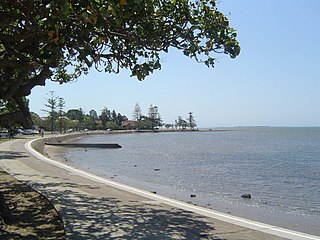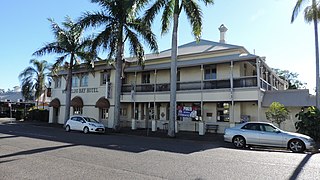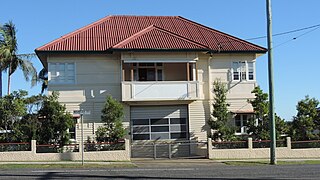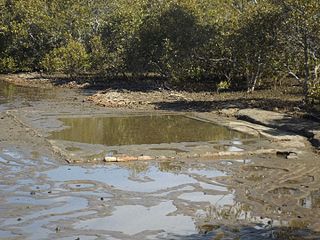
Moreton Bay is a bay located on the eastern coast of Australia 14 kilometres (8.7 mi) from central Brisbane, Queensland. It is one of Queensland's most important coastal resources. The waters of Moreton Bay are a popular destination for recreational anglers and are used by commercial operators who provide seafood to market.

A jetty is a structure that projects from land out into water. Often, "jetty" refers to a walkway accessing the centre of an enclosed waterbody. The term derives from the French word jetée, "thrown", signifying something thrown out.

The Gold Coast Broadwater, also known as Southport Broadwater, Gold Coast Harbour and The Broadwater, is a large shallow estuary of water located in the Gold Coast district of South East Queensland, Australia. The estuary reaches from the locality of Southport in the south, to the southern section of the UNESCO World Heritage Listed Moreton Bay in the north. Separated via the Seaway from the Coral Sea by a thin strip of land called Stradbroke Island, the original body of water was a lagoon created from water deposited from the Nerang River. Part of the Broadwater is contained within the Moreton Bay Marine Park.

Cleveland is a coastal locality and the central locality of Redland City, Queensland, Australia. In the 2016 census, Cleveland had a population of 14,801 people.

The intertidal zone, also known as the foreshore or seashore, is the area that is above water level at low tide and underwater at high tide. This area can include several types of habitats with various species of life, such as seastars, sea urchins, and many species of coral. Sometimes it is referred to as the littoral zone, although that can be defined as a wider region.

Wynnum is a coastal suburb in the City of Brisbane, Queensland, Australia. In the 2016 census, Wynnum had a population of 12,915.. The suburb is a popular destination in Brisbane due to its coastline, jetty and tidal wading pool.

Manly is an eastern coastal bayside suburb of the City of Brisbane, Queensland, Australia.

Lota is an eastern outer coastal suburb in the City of Brisbane, Queensland, Australia.

Point Lookout Light is an active lighthouse on Point Lookout, a headland on North Stradbroke Island, Queensland, Australia.

St Helena Island is a heritage-listed island in Queensland, Australia, 21 kilometres (13 mi) east of Brisbane and 4 kilometres (2.5 mi) east of the mouth of the Brisbane River in Moreton Bay. Originally used as a prison, it is now a national park. Local Australian Aborigines called the island Noogoon but it was renamed St Helena after an aboriginal named Napoleon was exiled there in 1827. The island is visible from the mainland, particularly the suburbs of Wynnum, Manly and Lota. It has its own permanent water supply, a spring in the centre of the island. Many migratory birds use the island as a watering hole; it forms part of the Moreton Bay and Pumicestone Passage Important Bird Area, so identified by BirdLife International because it supports large numbers of migratory waders, or shorebirds.

Fort Cowan Cowan is a heritage-listed World War II fortification at 30 Jessie Wadsworth Street, Moreton Island, City of Brisbane, Queensland, Australia. It is also known as RAN 3 Cowan Cowan, Fort Cowan and Cowan Cowan Battery. It was added to the Queensland Heritage Register on 1 October 2007.

Wynnum Ambulance Station is a heritage-listed museum and former ambulance station at 33 Tingal Road, Wynnum, City of Brisbane, Queensland, Australia. It was built from 1926 to 1927. It is also known as the Queensland Ambulance Museum and the QATB Station. It was added to the Queensland Heritage Register on 26 March 1999. It is open by appointment.

Waterloo Bay Hotel is a heritage-listed hotel at 75 Berrima Street, Wynnum, City of Brisbane, Queensland, Australia. It was built in 1889 by George Gibbs and extended in 1918 to a design by George Henry Male Addison. It was added to the Queensland Heritage Register on 28 July 2000.

Wynnum Fire Station is a heritage-listed former fire station at 39 Mountjoy Terrace, Wynnum, City of Brisbane, Queensland, Australia. It was designed by Atkinson & Conrad and built from 1922 to 1938. It was added to the Queensland Heritage Register on 28 May 1999.

Manly Retaining Wall is a heritage-listed embankment at Falcon Street, Manly, City of Brisbane, Queensland, Australia. It was designed by engineer Eneas Fraser Gilchrist and built in 1933 by relief workers. It is also known as The Great Wall of Manly. It was added to the Queensland Heritage Register on 5 October 1998.

The Michael Gannon residence is a heritage-listed holiday home at 150 Kingsley Terrace, Manly, City of Brisbane, Queensland, Australia. It was built c. 1888. It was added to the Queensland Heritage Register on 27 October 2000.

Christ Church Tingalpa and Burial Ground is a heritage-listed former Anglican church at 1341 Wynnum Road, Tingalpa, City of Brisbane, Queensland, Australia. It was built from 1868 to 1993. It is now known as the Pioneer Wedding Chapel. It was added to the Queensland Heritage Register on 2 February 1998.

Dunwich Convict Causeway is a heritage-listed causeway at Junner Street, Dunwich, North Stradbroke Island in the City of Redland, Queensland, Australia. It was built in 1827 by convict labour. It was added to the Queensland Heritage Register on 22 October 1999.

Point Lookout Foreshore is a heritage-listed headland at East Coast Road, Point Lookout, City of Redland, Queensland, Australia. It is also known as Mooloomba. It was added to the Queensland Heritage Register on 27 August 2004.

Deception Bay Sea Baths are heritage-listed swimming pools at Captain Cook Parade, Deception Bay, Moreton Bay Region, Queensland, Australia. They were built around the 1880s and 1890s by Joseph Bancroft. It is also known as Bancroft Sea Baths. It was added to the Queensland Heritage Register on 4 July 2006.
























